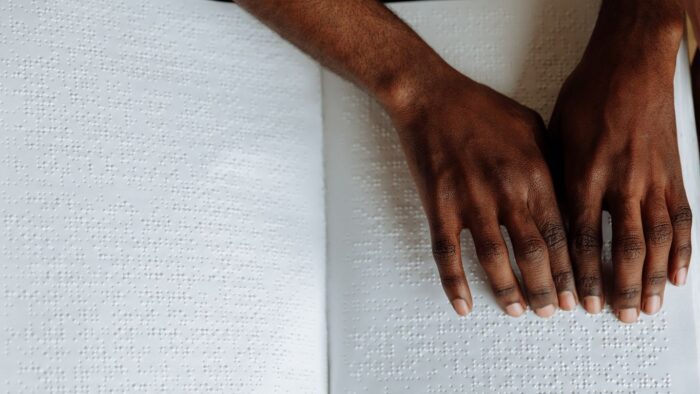Braille Choices: Paper vs. Electronic Braille?
Published onWhen you receive a request for braille documents, your business has an important decision: should you print it or opt for a digital alternative?
Like picking between chocolate or vanilla, the answer changes depending on personal preference.
When unsure, learning more about the different options should help you decide which to choose.
Two common types you’ll encounter are paper braille and electronic braille. In this article, we’ll provide an overview of each to help guide your decision.
Paper Braille Benefits
There are many appealing things about embossed braille. For starters, some readers prefer physical copies.
Another benefit of embossed braille is the ability to use both hands, allowing readers to scan pages quickly. This helps people sense formatting, anticipate length, and develop their literacy skills. Most digital versions, in contrast, only show a line at a time.
Plus you can read paper braille anytime–even when the power goes out!

Weaknesses of Paper Braille
With every great thing, there are still bound to be downsides. Embossed braille is no exception.
A fact that surprises companies is the size difference between a text and a braille document. Braille has to be big enough for a person’s fingertips to differentiate between characters. That means your one-page memo might turn into three to five braille pages.
While this has a minimal impact on smaller documents, it quickly becomes an issue with larger files like healthcare provider directories.
Additionally, braille requires an embosser to make copies. If you accidentally request too few copies, it will require another round of printing. For companies without the equipment, this means outsourcing the work again.
Electronic Braille Benefits
When you think of braille, you might not think of a digital file. However, a Braille Ready File (BRF) displays digital information in the tactile code.
Screen readers and embossers use these files to print or display documents to people with blindness.
BRFs are also a great option for large documents or books. Instead of lugging around volumes of a healthcare provider directory or your favorite Harry Potter book, you can navigate the electronic version with your portable braille display.
Without the concern of size, these documents are easily opened and viewed in tight spaces–like on an airplane.
Beyond cutting down on paper, digital versions can be stored and easily distributed. Since it’s digital, the file can be sent to multiple people at once–that way you don’t have to stress about not having enough copies.

Weaknesses of Electronic Braille
One of the largest downfalls of digital files is the need for technology. Unfortunately, not everyone has this equipment.
Many people struggle with the cost of necessary technology. Most electronic braille readers start at a thousand dollars. These readers also need a computer or mobile device to access the BRF.
Plus, it’s not guaranteed that your customer can use a computer. Every customer request will have needs specific to their abilities and it’s your responsibility to meet them.
Another downfall to this option is that formatting can be lost when transitioning from the braille software’s native file type to BRF. That means headings, lists, and tables may not read correctly for the end user.
Did you know…?
Some people who have a visual disability cannot read braille, so other formats, like accessible PDFs, are a good alternative. Accessible PDFs are an especially good choice if your customer requests a digital file. Why? Because they can listen to it or read it with their braille display!
Which Should You Choose?
Ultimately, it doesn’t have to be a guessing game. When you receive a request for braille, ask the customer what they prefer.
Making the effort to meet their needs shows you care and are committed to accessibility. It can also educate you on the best format for your company.
When in doubt, paper braille is your best bet. It doesn’t require any additional equipment to read the requested information.
Next time you receive a request, keep these tips in mind when determining whether to print braille or go digital.
Categorized in: Accessibility, Informational, Opinion, Technology
This post was written by



Comments are closed here.